This is an AI Free Zone! Text created by ChatGPT and other Large Language Models is spreading rapidly across the Internet. It's well-written, artificial, frequently inaccurate. If you find a mistake on Spaceweather.com, rest assured it was made by a real human being. | | |
TWO CME IMPACTS ADD UP TO NOTHING: As predicted, CMEs hit Earth's magnetic field on July 20th and 21st. However, the two impacts were weak and did not trigger even a minor geomagnetic storm. Quiet conditions should continue through the weekend because no additional CMEs are heading our way. Solar flare alerts: SMS Text
SPACEX PUNCHED A HOLE IN THE IONOSPHERE (UPDATED): On the evening of July 19th, SpaceX launched a Falcon 9 rocket from Vandenberg Space Force Base in California. Sky watchers from southern California to Arizona witnessed a magnificent exhaust plume. At the San Francisco Volcanic Field north of Flagstaff, photographer Jeremy Perez saw something extra:
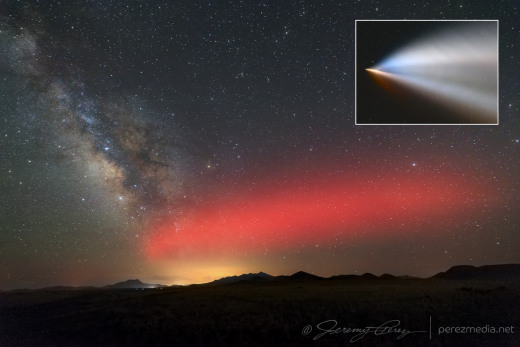
"After the rocket passed overhead, a red fluorescent glow expanded southward and crossed over the Milky Way," says Perez. "It was visible for almost 20 minutes."
The red glow is a sign that the rocket punched a hole in the ionosphere--something SpaceX and others have been doing for years. One famous example occured on August 25, 2017, when a Falcon 9 rocket carrying Taiwan’s FORMOSAT-5 satellite created a hole four times bigger than the state of California. On June 19, 2022, another Falcon 9 punched a hole over the east coast of the USA, sparking a display of red lights from New York to the Carolinas that many observers mistook for aurora borealis.
"This is a well studied phenomenon when rockets are burning their engines 200 to 300 km above Earth's surface," explains space physicist Jeff Baumgardner of Boston University. "The red glow appears when exhaust gasses from the rocket's 2nd stage cause the ionosphere to recombine quickly."
Rocket engines spray water (H2O) and carbon dioxide (CO2) into the ionosphere, quenching local ionization by as much as 70%. A complicated series of charge exchange reactions between oxygen ions (O+) and molecules from the rocket exhaust produce photons at a wavelength of 6300 Å--the same color as red auroras.
This movie from David Blanchard outside Flagstaff shows how the red glow developed as the silvery rocket exhaust faded into the ionosphere:
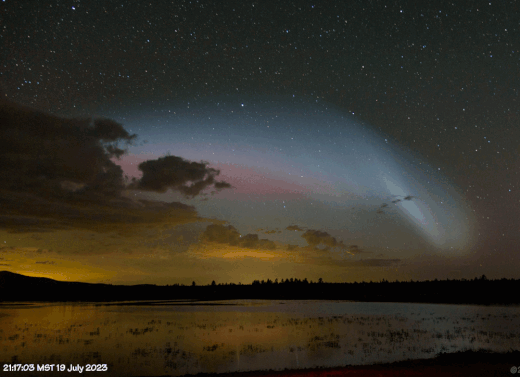
"I watched the show from Upper Lake Mary in the Coconino National Forest," says Blanchard. "The exhaust plume was spectacular."
Baumgardner reviewed SpaceX's video footage from the July 19th launch. "It shows the second stage engine burning at 286 km near the ionosphere's F-region peak for that time of day. So, it is quite possible that an ionospheric 'hole' was made," he says.
Once rare, ionospheric "punch holes" are increasingly common with record numbers of rocket launches led by SpaceX sending Starlink satellites to low-Earth orbit. Ham radio operators may notice them when shortwave signals fail to skip over the horizon, shooting through holes instead of bouncing back to Earth. Sudden GPS errors can also result from the anomalies. These effects may be troublesome, but they are shortlived; re-ionization occurs as soon as the sun comes up again.
Readers, did you see a red glow from this week's SpaceX launch? Submit your photos here.
more images: from Cheryl Hanscom Wilcox of Mammoth Lakes, CA; from MaryBeth Kiczenski in the San Juan Mountains of Colorado; from Richard Rast of Mountainair, New Mexico;
Realtime Space Weather Photo Gallery
Free: Spaceweather.com Newsletter
FANTASTIC DRAGON SPACE PENDANT: How high can a dragon fly? On July 14th, this one hitched a ride onboard an Earth to Sky Calculus cosmic ray research balloon, reaching an altitude of 117,524 ft:
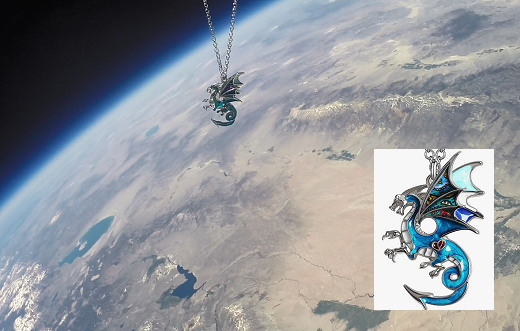
You can have it for $124.95. The pendant is hand-crafted with colorful enamel inlaid on a hypoallergenic alloy "dragon skeleton." It makes a great gift for anyone who loves fantasy and dragonlore.
The students are selling space pendants to support their cosmic ray ballooning program. Each one comes with a greeting card showing the pendant in flight and telling the story of its trip to the stratosphere and back again.
Far Out Gifts: Earth to Sky Store
All sales support hands-on STEM education
Realtime Noctilucent Cloud Photo Gallery
Free: Spaceweather.com Newsletter
Realtime Aurora Photo Gallery
Free: Spaceweather.com Newsletter
Every night, a network of
NASA all-sky cameras scans the skies above the United States for meteoritic fireballs. Automated software maintained by NASA's Meteoroid Environment Office calculates their orbits, velocity, penetration depth in Earth's atmosphere and many other characteristics. Daily results are presented here on Spaceweather.com.
On Jul 22, 2023, the network reported 7 fireballs.
(7 sporadics)
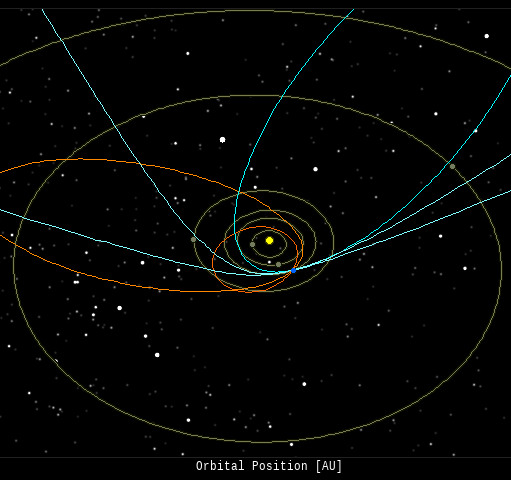
In this diagram of the inner solar system, all of the fireball orbits intersect at a single point--Earth. The orbits are color-coded by velocity, from slow (red) to fast (blue). [Larger image] [movies]
Potentially Hazardous Asteroids (
PHAs) are space rocks larger than approximately 100m that can come closer to Earth than 0.05 AU. None of the known PHAs is on a collision course with our planet, although astronomers are finding
new ones all the time.
On July 22, 2023 there were 2335 potentially hazardous asteroids.
 |
Recent & Upcoming Earth-asteroid encounters: | Asteroid | Date(UT) | Miss Distance | Velocity (km/s) | Diameter (m) |
| 2020 UQ3 | 2023-Jul-18 | 3.2 LD | 9.3 | 59 |
| 2023 OA | 2023-Jul-19 | 6.2 LD | 7.5 | 18 |
| 2023 NE1 | 2023-Jul-19 | 12.7 LD | 5.7 | 60 |
| 2022 GX2 | 2023-Jul-20 | 11.9 LD | 9.4 | 5 |
| 2023 NL | 2023-Jul-20 | 19.1 LD | 5.5 | 43 |
| 2020 OM | 2023-Jul-20 | 8.5 LD | 9.5 | 14 |
| 2023 OS | 2023-Jul-21 | 5.1 LD | 10.8 | 48 |
| 2023 NM1 | 2023-Jul-21 | 13.3 LD | 8.9 | 35 |
| 2023 MX5 | 2023-Jul-21 | 11.9 LD | 11.8 | 62 |
| 2023 NR1 | 2023-Jul-22 | 2.9 LD | 15.2 | 77 |
| 2023 MM3 | 2023-Jul-22 | 19.1 LD | 6.4 | 46 |
| 2023 OU | 2023-Jul-22 | 1.8 LD | 6.1 | 22 |
| 2015 MA54 | 2023-Jul-24 | 16.6 LD | 9.2 | 31 |
| 2023 OW | 2023-Jul-25 | 19.8 LD | 8.7 | 40 |
| 2018 BG5 | 2023-Jul-27 | 10.8 LD | 8.4 | 56 |
| 2020 PP1 | 2023-Jul-29 | 17 LD | 4.1 | 17 |
| 2021 BD3 | 2023-Jul-30 | 14 LD | 8.5 | 25 |
| 2016 AW65 | 2023-Jul-31 | 16.7 LD | 5.7 | 54 |
| 2020 PN1 | 2023-Aug-03 | 10.8 LD | 4.8 | 29 |
| 620082 | 2023-Aug-04 | 14 LD | 20.6 | 375 |
| 2023 OQ | 2023-Aug-06 | 10 LD | 21.4 | 147 |
| 2004 KG1 | 2023-Aug-06 | 18.7 LD | 9.2 | 54 |
| 2022 BS2 | 2023-Aug-11 | 17.3 LD | 8.2 | 30 |
| 2022 CP1 | 2023-Aug-17 | 13.8 LD | 9.8 | 12 |
| 2011 QJ21 | 2023-Aug-19 | 13 LD | 15.1 | 45 |
| 6037 | 2023-Aug-23 | 15.9 LD | 14.3 | 563 |
| 2012 PZ17 | 2023-Aug-30 | 16.8 LD | 3.6 | 16 |
| 2017 BY32 | 2023-Sep-02 | 16.4 LD | 3.5 | 20 |
| 2021 JA5 | 2023-Sep-06 | 13.3 LD | 10.9 | 19 |
| 2020 GE | 2023-Sep-08 | 14.9 LD | 1.4 | 8 |
| 2020 RT2 | 2023-Sep-12 | 11 LD | 10 | 8 |
| 2016 LY48 | 2023-Sep-16 | 5 LD | 10.8 | 100 |
| 2010 TE | 2023-Sep-16 | 6.8 LD | 6 | 22 |
Notes: LD means "Lunar Distance." 1 LD = 384,401 km, the distance between Earth and the Moon. 1 LD also equals 0.00256 AU. | | Cosmic Rays in the Atmosphere |
SPACE WEATHER BALLOON DATA: Almost once a week, Spaceweather.com and the students of Earth to Sky Calculus fly space weather balloons to the stratosphere over California. These balloons are equipped with sensors that detect secondary cosmic rays, a form of radiation from space that can penetrate all the way down to Earth's surface. Our monitoring program has been underway without interruption for 7 years, resulting in a unique dataset of in situ atmospheric measurements.
Latest results (July 2022): Atmospheric radiation is decreasing in 2022. Our latest measurements in July 2022 registered a 6-year low:
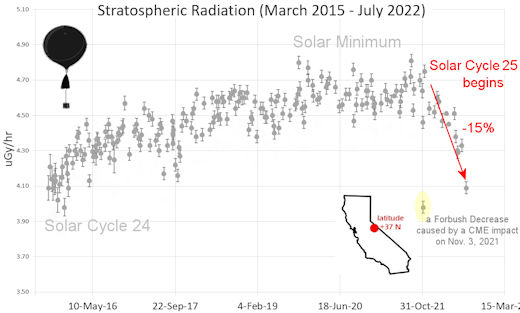
What's going on? Ironically, the radiation drop is caused by increasing solar activity. Solar Cycle 25 has roared to life faster than forecasters expected. The sun's strengthening and increasingly tangled magnetic field repels cosmic rays from deep space. In addition, solar coronal mass ejections (CMEs) sweep aside cosmic rays, causing sharp reductions called "Forbush Decreases." The two effects blend together to bring daily radiation levels down.
.Who cares? Cosmic rays are a surprisingly "down to Earth" form of space weather. They can alter the chemistry of the atmosphere, trigger lightning, and penetrate commercial airplanes. According to a study from the Harvard T.H. Chan school of public health, crews of aircraft have higher rates of cancer than the general population. The researchers listed cosmic rays, irregular sleep habits, and chemical contaminants as leading risk factors. A number of controversial studies (#1, #2, #3, #4) go even further, linking cosmic rays with cardiac arrhythmias and sudden cardiac death.
Technical notes: The radiation sensors onboard our helium balloons detect X-rays and gamma-rays in the energy range 10 keV to 20 MeV. These energies span the range of medical X-ray machines and airport security scanners.
Data points in the graph labeled "Stratospheric Radiation" correspond to the peak of the Regener-Pfotzer maximum, which lies about 67,000 feet above central California. When cosmic rays crash into Earth's atmosphere, they produce a spray of secondary particles that is most intense at the entrance to the stratosphere. Physicists Eric Regener and Georg Pfotzer discovered the maximum using balloons in the 1930s and it is what we are measuring today.
| | The official U.S. government space weather bureau |
| | The first place to look for information about sundogs, pillars, rainbows and related phenomena. |
| | Researchers call it a "Hubble for the sun." SDO is the most advanced solar observatory ever. |
| | 3D views of the sun from NASA's Solar and Terrestrial Relations Observatory |
| | Realtime and archival images of the Sun from SOHO. |
| | information about sunspots based on the latest NOAA/USAF Active Region Summary |
| | current counts of failed and deployed Starlink satellites from Jonathan's Space Page |
| | Authoritative predictions of space junk and satellite re-entries |
| | from the NOAA Space Environment Center |
| | fun to read, but should be taken with a grain of salt! Forecasts looking ahead more than a few days are often wrong. |
| | from the NOAA Space Environment Center |
| | the underlying science of space weather |
 | Getting YouTube comments is essential if you want to beat the algorithm! That’s why you need to buy YouTube comments from RealSocialz.com because they offer real USA comments you can customize. |
 | When looking for casinos to play online when the weather is bad, you can try casino online trucchi for Italian games. If you are not from Finland you can try the Swedish page Svenska casino online to find suitable games, check out svenskacasinoonline.net. Always check your local laws before playing with real money. |
 | BestCSGOGambling is the best site for everything related to CSGO gambling on the web |
| | These links help Spaceweather.com stay online. Thank you to our supporters! |
| | | | | | |

